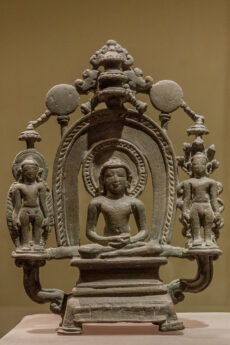Bronze figure from the Government Museum Chennai.
Description
This is a beautiful Trithirthi bronze, which has the figures of three Tirthankaras. But in the Museum Register, it is recorded as Trithankara. The Mula Nayaka (Main Tirthankara is depicted in the Ardha-Paryakasana seated posture on rectangular pedestal. The four legs inverted U-shaped Prabhavali for seated Mula Nayaka is designed with Bha Mandala on each side are fixed at the back of the Prabhavali.
These are usually carried when processions of deities and royalty are taken out. Two carved stalk like brackets, with a round top on which the other two Tirthankara figures stand, are attached at the dorsal sides of the pedestal.
The standing Tirthankara image on the left side of the Mula Nayaka figure is shown with a five-headed snake, which spreads its hood as canopy over the heads of Tirthankara. Over background the presence of the five headed cobra helps to identify the figure as that of Suparsvanatha. The figure of the Tirthankara on the right side of the Mula Nayaka is Mandala.
In the absence of the cognisance figure on the pedestal, it is difficult to identify the figure of the Mula Nayaka. However, Trithirthi groups of Adinatha, Parsvanatha and Mahavira have also been discovered in several places.
Trithirthi images were popular at Digambara sites and a good number of such sculptures datable to the period between 9th and 12th Centuries AD are found in Deogarh and Khajuraho (Tiwari, Maruti Nandan Prasad).
From the design of the pedestal, its carved brackets on top of which two figures of standing Tirthankaras are depicted and the posture of this ensemble of the Trithirthis may be dated to Circa 11th Century AD.1
Informations
Acc. No.: 393/57
Century: 11th CE
Place of discovery: Singanikuppam
Taluk: Tindivanam
District: Viluppuram (Erstwhile South Arcot)
State: Tamil Nadu
Country: India
Exhibition Location: Government Museum Chennai
Height: 19 cm
Breadth: 14 cm
Weight: no information about the weight
Pictures
Map
- Website of the Government Museum Chennai: https://www.chennaimuseum.org/draft/gallery/01/05/052/jain1.htm, 2024 ↩


Leave a Reply